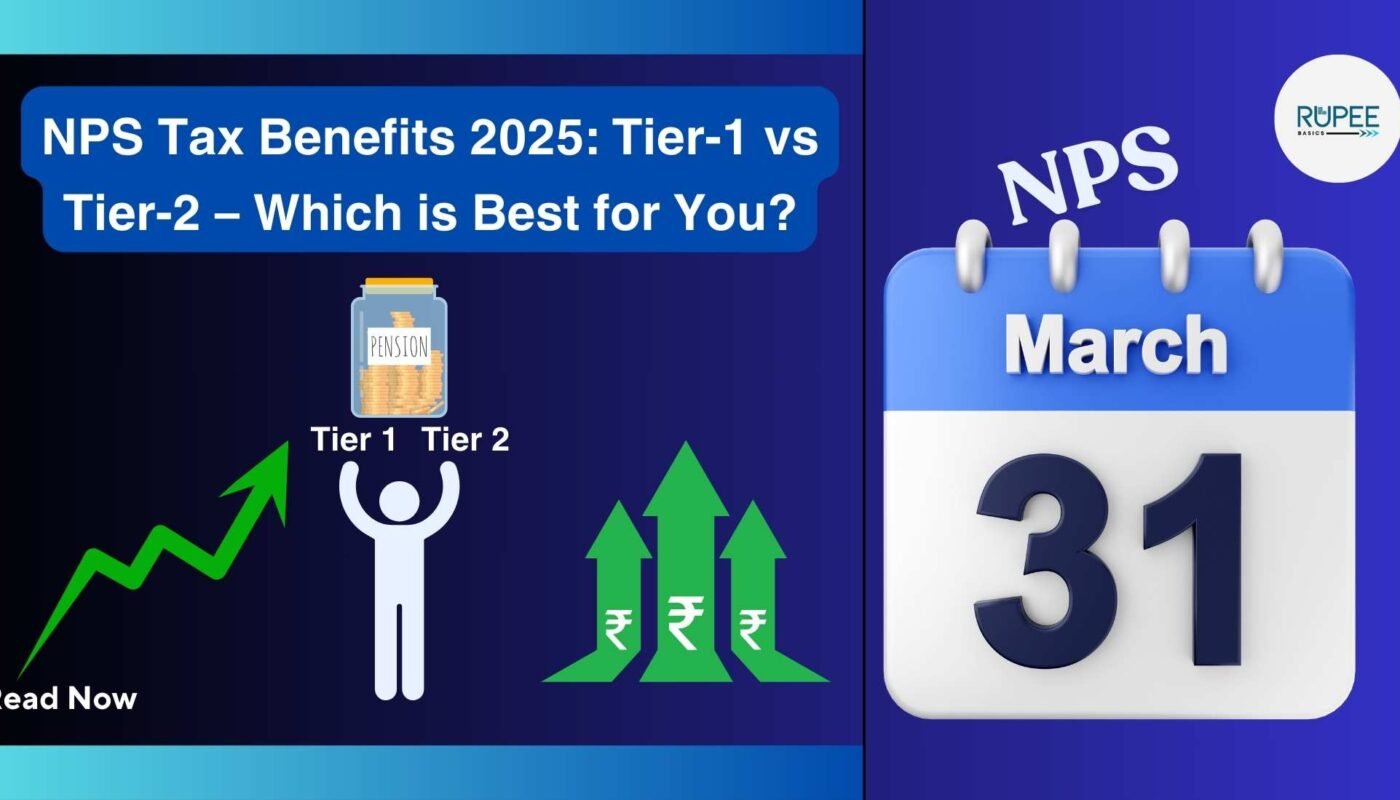Introduction
As the financial year-end approaches, many taxpayers scramble to find ways to maximize their deductions and reduce their tax liability. One of the most popular options for tax savings is the National Pension System (NPS). However, there is often confusion between NPS Tier-1 and Tier-2 accounts—especially when it comes to tax benefits.
If you’re looking for a last-minute tax-saving option, this guide will help you understand the key differences between NPS Tier-1 and Tier-2 and determine which one is better for tax-saving purposes.
Understanding NPS and Its Tax Benefits
NPS is a government-backed voluntary retirement savings scheme designed to provide financial security after retirement. It has two types of accounts:
1. NPS Tier-1 Account (Retirement Account)
- This is a mandatory pension account with restrictions on withdrawals before retirement.
- It comes with tax benefits under Section 80CCD(1) and Section 80CCD(1B).
- The investment is locked until the age of 60, except under certain conditions.
2. NPS Tier-2 Account (Voluntary Investment Account)
- This is an optional savings account with no withdrawal restrictions.
- It does not offer tax benefits for private-sector employees.
- It is more like a flexible investment account that allows anytime withdrawals.
How Does NPS Invest Money?
NPS invests investors’ money in a diversified portfolio managed by Pension Fund Managers (PFMs). Investors can choose between Active Choice (where they select asset allocation) and Auto Choice (where allocation is done based on age).
Investment Categories:
- Equity (E): Up to 75% allocation in stocks for higher returns.
- Corporate Bonds (C): Debt instruments offering stable returns.
- Government Bonds (G): Secure investments with lower risk.
- Alternative Assets (A): Real estate investment trusts (REITs), infrastructure, etc.
Over time, NPS investments aim to generate wealth while ensuring financial security post-retirement.
Who Should Invest in NPS?
NPS is suitable for:
✅ Salaried Employees: Looking for long-term retirement savings with tax benefits. ✅ Self-Employed Professionals: Seeking additional pension benefits while enjoying tax deductions. ✅ Government Employees: Who get mandatory NPS contributions from their employer. ✅ Young Investors: Who want disciplined retirement savings and compounding benefits. ✅ Taxpayers Needing Deductions: Those looking to claim additional tax benefits under Section 80CCD(1B).
If you need both tax benefits and retirement security, NPS is a great investment choice.
NPS Tax Benefits: Tier-1 vs Tier-2
| Feature | NPS Tier-1 | NPS Tier-2 |
|---|---|---|
| Tax Benefit | Yes, under Section 80CCD(1) & 80CCD(1B) | No tax benefit for private-sector employees (Only Govt. employees under Section 80C) |
| Maximum Deduction | Up to Rs. 2 Lakhs (Rs. 1.5L under 80CCD(1) + Rs. 50,000 under 80CCD(1B)) | Not applicable (except for government employees) |
| Lock-in Period | Till the age of 60 | No lock-in period |
| Withdrawal Rules | Restricted withdrawals before 60 | Free withdrawals anytime |
| Suitability | Best for tax-saving & retirement planning | Suitable for short-term investments, not tax-saving |
| Employer Contributions: | If your employer contributes to your NPS, it’s eligible for deduction under Section 80CCD(2), up to 10% of your salary (14% for government employees). | No Deduction in Tier 2 |
Which is Better for Last-Minute Tax Savings?
If your goal is tax saving before the deadline, NPS Tier-1 is the clear winner. Here’s why:
✅ NPS Tier-1 provides up to Rs. 2 lakh deduction under Section 80CCD(1) and 80CCD(1B). ✅ Contributions are tax-deductible immediately once you invest before the NPS deadline 2025. ✅ Government employees can claim tax benefits on Tier-2 under Section 80C, but private-sector employees cannot. ✅ While Tier-2 offers liquidity, it does not offer last-minute tax benefits for most individuals.
If you’re rushing to invest before the financial year-end (March 31, 2025), opt for NPS Tier-1.
How to Claim Tax Benefits for NPS Contributions?
Follow these steps to claim tax benefits on NPS Tier-1 investments:
Step 1: Open an NPS Account
- If you don’t have an NPS Tier-1 account, you can open it online via the eNPS portal (https://enps.nsdl.com).
Step 2: Make a Contribution Before March 31
- Ensure your investment is credited before the NPS deadline 2025.
Step 3: Collect Investment Proof
- Download your NPS contribution receipt from your CRA (NSDL/KFintech) account.
Step 4: File Your ITR & Claim Deductions
- Add the NPS Tier-1 investment amount under Section 80CCD(1) & 80CCD(1B) in your Income Tax Return (ITR).
Conclusion: Should You Invest in NPS for Last-Minute Tax Savings?
If you are looking for an effective and quick tax-saving option, NPS Tier-1 is a great choice. It helps you save taxes up to Rs. 2 lakh and also builds a retirement corpus. However, if you need flexible withdrawals, then Tier-2 might be a better option, but it does not provide tax benefits for private employees.
🚀 Final Tip: Invest in NPS Tier-1 before March 31, 2025, to maximize your tax savings and secure your future!
FAQs
1. Can I get tax benefits on NPS Tier-2?
- No, only government employees can claim deductions on Tier-2 under Section 80C. Private-sector employees do not get tax benefits on Tier-2.
2. How much tax can I save with NPS Tier-1?
- You can claim up to Rs. 2 lakh in deductions (Rs. 1.5 lakh under 80CCD(1) and Rs. 50,000 under 80CCD(1B)).
3. What is the last date to invest in NPS for tax savings in 2025?
- The NPS deadline for tax benefits is March 31, 2025.
4. Can I withdraw money from NPS Tier-1 before retirement?
- Partial withdrawals are allowed under certain conditions, but the full amount can only be withdrawn after retirement at age 60.
5. How do I invest in NPS instantly?
- You can invest online through the eNPS portal using net banking, UPI, or credit/debit cards.
“Money flows to those who understand it and respect it”




